Jarick
Rock Star
- Messages
- 3,353
Over the last few months, I've been experimenting with running my Fractal Axe FX 3 through a power amp and speaker instead of studio monitors or headphones. I tried a few different solid state amps with flat power amps, and found that while I liked the sound in some ways more than monitors, it wasn't great.
So I tried a few different amps and speakers. I started with the Line 6 Catalyst which sounded good but a bit muddy. Then a Boss Katana 50 which was noticeably brighter. Then a Celestion V-Type which improved the Boss a bit but not the Line 6. Then a Boss Katana Artist Mk 2 which was much bigger and more balanced sounding.
Still, it wasn't blowing me away. The sound was too bright from what I would expect when running cab sims off, and turning them on just meant I was running a guitar speaker emulation into a guitar speaker, which made no sense.
So I ended up buying a Blackstar HT-5 Mk 2 tube amp that featured an effects loop, and I really liked the sound of the Fractal into that a lot more than the Katana, even running into the same speaker and cab. Then I got a Two Notes Torpedo Captor which is a loadbox and DI, and made some measurements using Room EQ Wizard.
First off, the Torpedo Captor has a speaker impedance curve that kind of simulates a guitar speaker, although it's not really close to a real curve. There's a smooth scoop in the mids rather than a big low end spike and steeper rise in the treble frequencies. Still, it's a baseline.
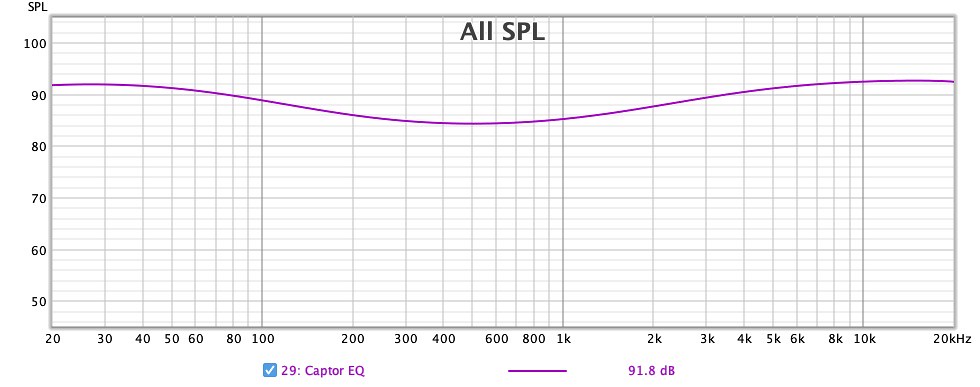
Next, here's the measurement of the Boss Katana Artist. I used the Power Amp In for both 0.5 watt and 50 watt modes, plus the effects loop return for 0.5 watt mode. You can see there's no frequency response difference, just a little bit of level differences as I didn't fully normalize volumes. And in general, it looks really close to the Torpedo Captor by itself.
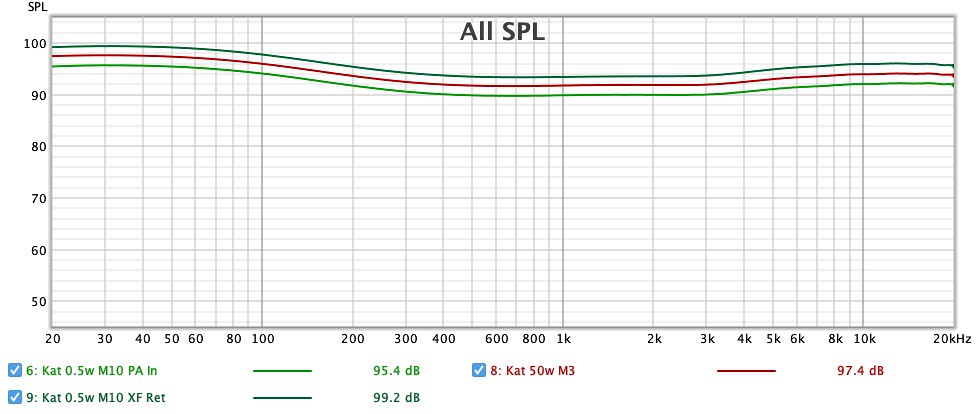
Then, I tried all of the different Contour and Cab Resonance settings, and found they had zero impact on the tone when running through the back panel and bypassing the preamp section. Here you can see everything overlaid and it's literally the same line (again slight volume difference between power amp input and effects loop return).
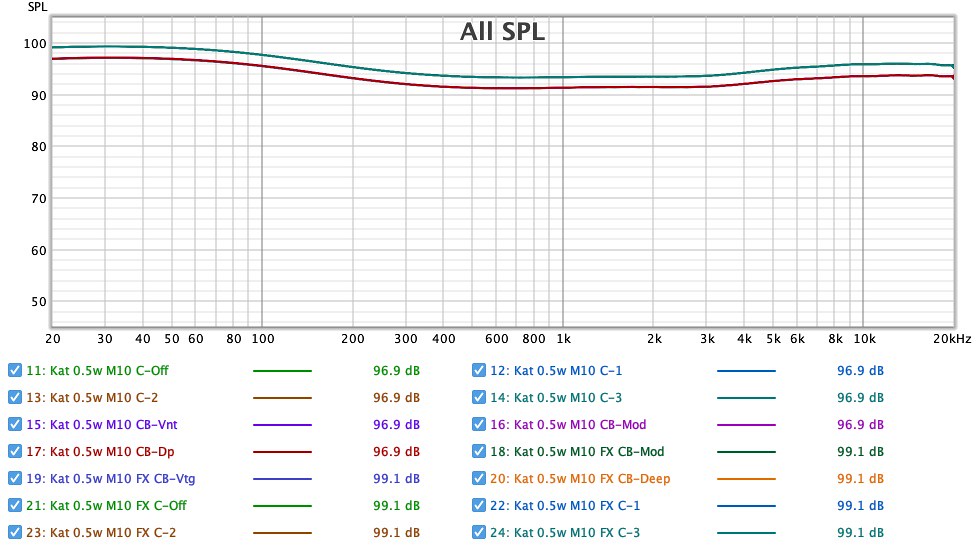
Everything's looking pretty flat so far. Now let's look at the Blackstar HT-5, which is a five watt amp running a single 12AX7 in the preamp and 12BH7 in the power amp. There's the standard 5 watt mode and a reduced volume 0.5 watt mode.
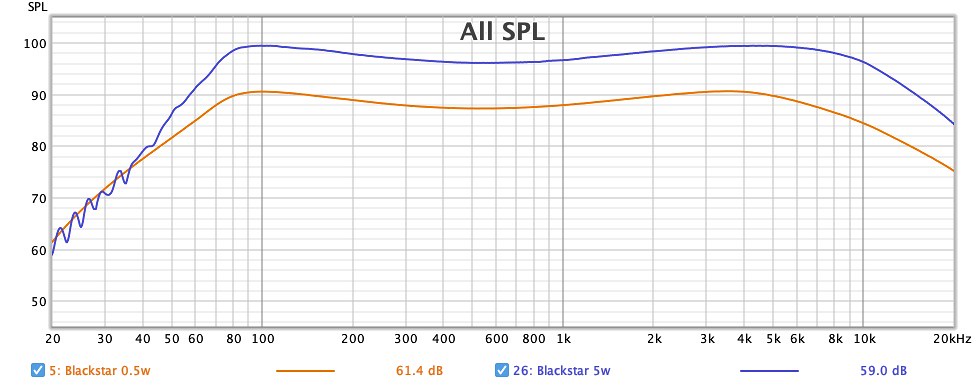
That's wildly different than the Katana! We'll compare those in just a minute, but one interesting thing here is that, aside from the ~ 10 dB in volume difference, there's less high end in the 0.5 watt mode, with a lower cutoff frequency and steeper slope. Anyways, here's the Blackstar in 5 watt mode compared to the Katana:
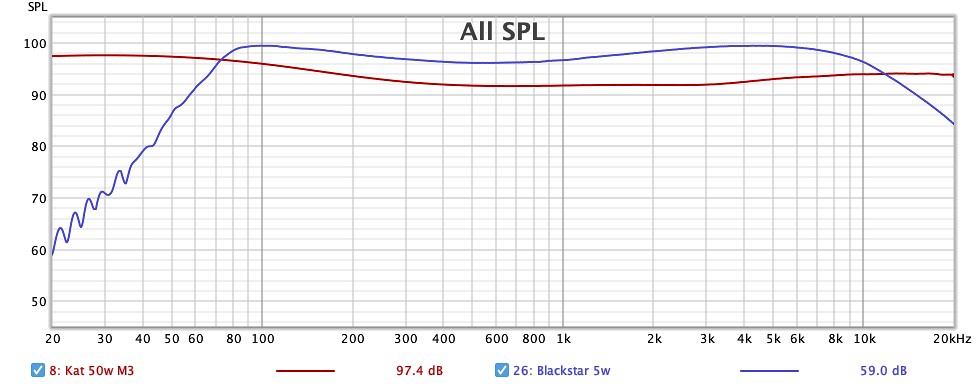
Huge difference in frequency response. The Katana, considering the Captor's impedance curve, looks really flat. The Blackstar has a high pass filter on the lows, a low pass filter on the highs, and a more pronounced midrange scoop.
So I switched to running the test signal through the Axe FX 3, put in a parametric EQ curve, and tweaked it for a couple minutes until it looked pretty close.
Low cut at 80 Hz (slope = 24 db/oct)
High shelf +4 dB at 2.0 kHz (Q = 0.7)
High cut at 7.0 kHz (slope = 6 db/oct)
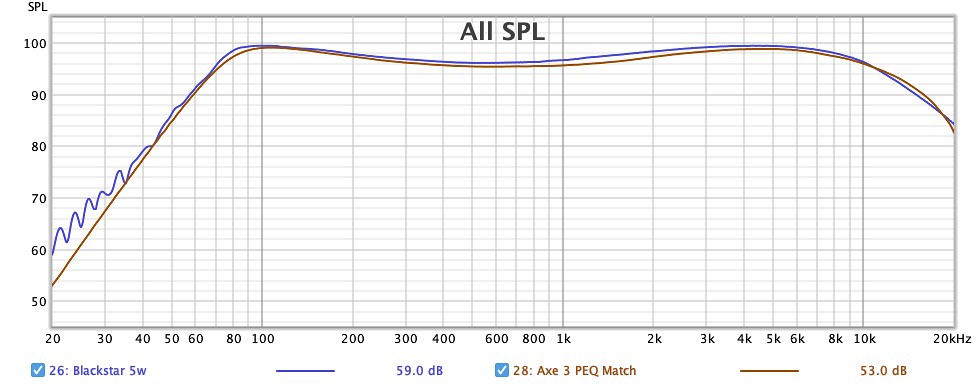
At this point I compared the Blackstar against the Katana and still preferred the tube amp. I tweaked the EQ by ear and that got me to a better place, with a little more low end and a little less highs.
Low cut at 75 Hz (slope = 18 db/oct)
Low shelf +1 dB at 100 Hz (Q = 0.7)
High shelf +1 dB at 2.5 kHz (Q = 0.7)
High cut at 7.5 kHz (slope at 12 db/oct)
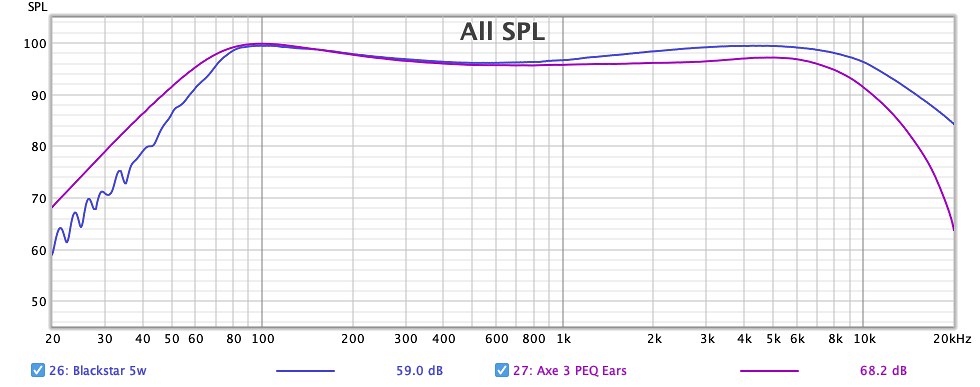
What's interesting to me is that my EQ settings to match the solid state amp to the tube amp are pretty damn close to what you would normally use on an impulse response. 80 Hz and 8 kHz are extremely common starting points.
Anyways, this was a really interesting and fun experiment. I wish I had more amps that I could measure, but I already spent $500 just to satisfy my curiosity.
Also, I've got a Kemper Profiler being delivered tomorrow and I've got no plans to get rid of my HX Stomp and Axe FX 3. Any requests for the next episode?
-----
Measurement details for the curious:
I used a MOTU M4 audio interface for all measurements. Ran the test signal from the MOTU line output, and the return signal into the line input. With the Torpedo Captor, I kept the line out level maxed as I was running it passively. I did have to compensate the output levels and/or input gain, but tried to match the -12 dB return level so no clipping at the interface. Also, I measured the interface and it's basically ruler flat, so no worries there. To measure the Captor's frequency response, I had to really boost the line out level and boost the input gain, but it looked pretty clean without a lot of noise or distortion.
So I tried a few different amps and speakers. I started with the Line 6 Catalyst which sounded good but a bit muddy. Then a Boss Katana 50 which was noticeably brighter. Then a Celestion V-Type which improved the Boss a bit but not the Line 6. Then a Boss Katana Artist Mk 2 which was much bigger and more balanced sounding.
Still, it wasn't blowing me away. The sound was too bright from what I would expect when running cab sims off, and turning them on just meant I was running a guitar speaker emulation into a guitar speaker, which made no sense.
So I ended up buying a Blackstar HT-5 Mk 2 tube amp that featured an effects loop, and I really liked the sound of the Fractal into that a lot more than the Katana, even running into the same speaker and cab. Then I got a Two Notes Torpedo Captor which is a loadbox and DI, and made some measurements using Room EQ Wizard.
First off, the Torpedo Captor has a speaker impedance curve that kind of simulates a guitar speaker, although it's not really close to a real curve. There's a smooth scoop in the mids rather than a big low end spike and steeper rise in the treble frequencies. Still, it's a baseline.

Next, here's the measurement of the Boss Katana Artist. I used the Power Amp In for both 0.5 watt and 50 watt modes, plus the effects loop return for 0.5 watt mode. You can see there's no frequency response difference, just a little bit of level differences as I didn't fully normalize volumes. And in general, it looks really close to the Torpedo Captor by itself.

Then, I tried all of the different Contour and Cab Resonance settings, and found they had zero impact on the tone when running through the back panel and bypassing the preamp section. Here you can see everything overlaid and it's literally the same line (again slight volume difference between power amp input and effects loop return).

Everything's looking pretty flat so far. Now let's look at the Blackstar HT-5, which is a five watt amp running a single 12AX7 in the preamp and 12BH7 in the power amp. There's the standard 5 watt mode and a reduced volume 0.5 watt mode.

That's wildly different than the Katana! We'll compare those in just a minute, but one interesting thing here is that, aside from the ~ 10 dB in volume difference, there's less high end in the 0.5 watt mode, with a lower cutoff frequency and steeper slope. Anyways, here's the Blackstar in 5 watt mode compared to the Katana:

Huge difference in frequency response. The Katana, considering the Captor's impedance curve, looks really flat. The Blackstar has a high pass filter on the lows, a low pass filter on the highs, and a more pronounced midrange scoop.
So I switched to running the test signal through the Axe FX 3, put in a parametric EQ curve, and tweaked it for a couple minutes until it looked pretty close.
Low cut at 80 Hz (slope = 24 db/oct)
High shelf +4 dB at 2.0 kHz (Q = 0.7)
High cut at 7.0 kHz (slope = 6 db/oct)

At this point I compared the Blackstar against the Katana and still preferred the tube amp. I tweaked the EQ by ear and that got me to a better place, with a little more low end and a little less highs.
Low cut at 75 Hz (slope = 18 db/oct)
Low shelf +1 dB at 100 Hz (Q = 0.7)
High shelf +1 dB at 2.5 kHz (Q = 0.7)
High cut at 7.5 kHz (slope at 12 db/oct)

What's interesting to me is that my EQ settings to match the solid state amp to the tube amp are pretty damn close to what you would normally use on an impulse response. 80 Hz and 8 kHz are extremely common starting points.
Anyways, this was a really interesting and fun experiment. I wish I had more amps that I could measure, but I already spent $500 just to satisfy my curiosity.
Also, I've got a Kemper Profiler being delivered tomorrow and I've got no plans to get rid of my HX Stomp and Axe FX 3. Any requests for the next episode?
-----
Measurement details for the curious:
I used a MOTU M4 audio interface for all measurements. Ran the test signal from the MOTU line output, and the return signal into the line input. With the Torpedo Captor, I kept the line out level maxed as I was running it passively. I did have to compensate the output levels and/or input gain, but tried to match the -12 dB return level so no clipping at the interface. Also, I measured the interface and it's basically ruler flat, so no worries there. To measure the Captor's frequency response, I had to really boost the line out level and boost the input gain, but it looked pretty clean without a lot of noise or distortion.
Last edited:

